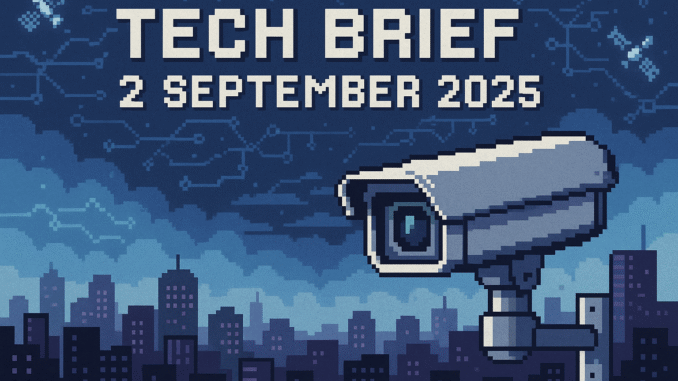
Tech Brief 2 September 2025 covers Palantir’s surveillance contract with Coventry Council, Europe’s satellite defence upgrades, and why flash storage prices are suddenly climbing. No time for digital déjà vu, but if you missed it, there’s always a way to catch up here before diving in.
Coventry Council Signs Palantir AI Deal for Children’s Services
“Are you sure you want to trust that software?” That’s the line staff gave Coventry City Council after it announced a £500,000 annual contract with Palantir, the US firm better known for military intelligence than local government admin. This is the first deal of its kind in Britain, and it’s already sparked resistance from public sector workers. Their concern is simple: should high-surveillance technology, originally built for things like mass deportation, be used in social services for vulnerable children?
Councillors claim it’s about efficiency. Anyone who’s ever wrangled with 80s council mainframes knows that “streamlined services” rarely mean less stress for frontline staff. A new database does not always mean a less anxious child protection worker in Coventry. The Palantir move marks a shift in public tech, but it’s also a new front in the privacy debate, one happening right on the doorstep.
EU Expands Satellite Network to Counter GPS Jamming Threats
Fact: the European Union is adding more satellites to low Earth orbit, aiming to protect digital infrastructure from GPS jamming. Officials say this is essential, as hostile actors increasingly target satellite navigation systems, the backbone for everything from city buses to supermarket deliveries. EU Defence Commissioner Andrius Kubilius laid out the risk: a GPS blackout can disrupt power stations and emergency services.
Back in the 90s, satellites seemed like science fiction. Now they’re as normal as radiators in winter. Attacks on satellite signals are up, which only highlights how fragile our digital navigation has become. The project is part caution, part necessity, and sits squarely in classic European belt and braces digital policy. If you can hear an early GPS voice mangling “Leamington Spa,” you’re not alone.
Flash Drive Prices Surge as SAS, SATA Standards Drift Apart
Why are flash drives suddenly more expensive? Manufacturers have pulled back production due to oversupply, which means prices are climbing for everything from everyday USB sticks to enterprise SAS drives. This stings for anyone building or restoring classic machines. Storage used to be the main bottleneck, and now we’re back to square one. SAS (Serial Attached SCSI) and SATA (Serial ATA) are splitting apart, making upgrades trickier for both data centres and retro hobbyists.
Not so long ago, you’d spend Saturday afternoons in Maplin, hunting for rare 2.5 inch IDE drives to keep an Amiga or Atari alive. Now it’s all about scrutinising supply chain forecasts instead of football scores. Like satellite infrastructure above, the risk isn’t just theoretical. It hits wherever digital memory becomes personal. No click of death nostalgia needed, just practical headaches.
From the Wayback Machine
From the Archives: May 1997 – IBM’s Deep Blue made history by defeating world chess champion Garry Kasparov in their rematch. The 32-node RS/6000 SP system, powered by 480 custom chess chips, marked the first time a computer beat a reigning world champion under tournament rules. Today, chess engines run on laptops, but Deep Blue’s legacy still shapes how we talk about artificial intelligence. The debate over transparent algorithms is far from over.
What This Means
Tech Brief 2 September 2025 shows how old anxieties keep resurfacing: data privacy, digital backbone security, and storage headaches. It’s not just nostalgia; when technology moves fast, the gaps show up for those who actually care about the kit.
Log off, dust off the 3.5 inch disks, and remember: curiosity always wins, even if the price per gigabyte disagrees.
Missed yesterday’s Tech Brief? Catch up here

Leave a Reply